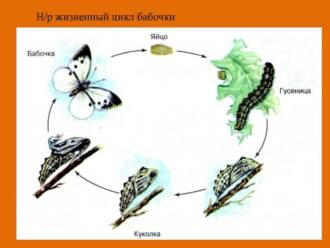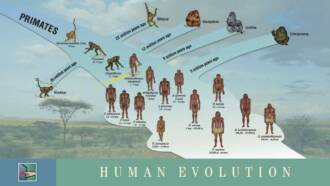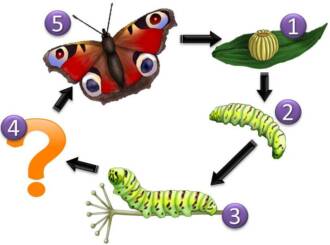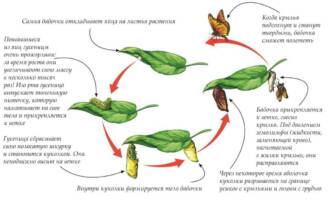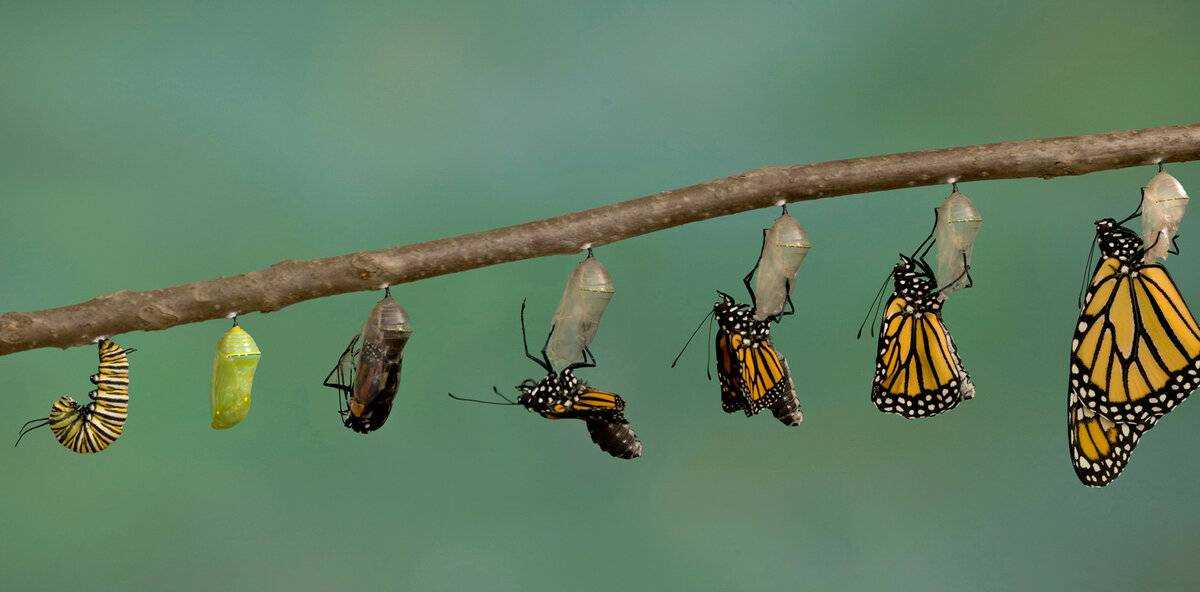
Butterflies are one of the most amazing and incredible creatures of nature. Their evolution is amazing and is one of the most studied areas of biology. The unique ability of butterflies to undergo transformations from a caterpillar to a beautiful insect arouses admiration and interest among scientists and nature lovers.
The process of turning a caterpillar into a butterfly is called metamorphosis. It begins with the laying of eggs by the female on certain plants, which will serve as food for the future caterpillar. A hungry caterpillar emerges from the egg, which actively feeds and grows. Her body is made up of many segments, each with a set of legs and small spikes for protection.
As the caterpillar grows, it goes through several molts, during which it sheds the old skin and replaces it with a new one. When the caterpillar reaches a certain size, it enters the stage of prepuce. At this point, she stops feeding and looks for a secluded place to form a chrysalis. A chrysalis is a special shell in which a caterpillar turns into a butterfly.
Amazing transformations take place inside the chrysalis. The caterpillar turns into an imago - a fully formed insect. During this process, the caterpillar's body decomposes and then reassembles to form the wings, legs, and other parts of the butterfly. After the end of these changes, the pupa splits, and an adult butterfly emerges from it, ready for flight and reproduction.
The original view of the caterpillar
The caterpillar is the first stage in the life cycle of a butterfly. In its initial form, the caterpillar is a small, crawling insect, usually with a soft, segmented body. It lives in a variety of environments, including forests, fields, gardens, and agriculture.
Caterpillars usually have many legs that allow them to move on the surface. They also possess chewing parts that help them feed on vegetation. Caterpillars can be of different sizes, shapes and colors, depending on the species. Some caterpillars may be covered with hairs or spines to protect them from predators.
Caterpillars are very active creatures, constantly looking for food and places to pupa. They typically feed on the leaves, stems, and flowers of plants, and their food preferences may vary by species. Caterpillars also play an important role in the ecosystem as a food source for many animals, including birds and insectivores.
Caterpillar metamorphosis to chrysalis

Metamorphosis is the amazing transformation that happens to caterpillars before they turn into beautiful butterflies. This process begins when the caterpillar reaches a certain stage of its development and is ready for change.
At this stage, the caterpillar begins to look for a place to create its chrysalis. It attaches itself to a branch or leaf with its back body and begins to create its protective shell.
The caterpillar begins to weave threads of a silk substance from its iron glands on the underside of its body. She weaves these threads together, creating a strong and flexible structure that will serve her like a cocoon.
When the cocoon is finished, the caterpillar begins the transformation inside it. She stops feeding and begins to decompose her tissues. Inside the pupa, amazing processes of growth and restructuring take place.
Within a few days or weeks, depending on the type of butterfly, the caterpillar fully transforms into a chrysalis. At this time, her body undergoes significant changes - the caterpillar's organs decompose, and the new organs of the future butterfly form and develop.
When the transformation is completed, the pupa becomes immobile and only from time to time there is a pulsation of its walls. Inside the chrysalis, the butterfly prepares for release: it forms wings, legs and other organs that it will need to survive after departure.
The process of turning a chrysalis into a butterfly
The process of turning a chrysalis into a butterfly is amazing and unique. After the caterpillar finishes its growth and feeding, it begins to form its chrysalis. The pupa is a hard shell that protects the caterpillar during the process of metamorphosis.
The pupa consists of three main parts: head, chest and abdomen. Amazing transformations take place inside the chrysalis. The caterpillar turns into a fully formed butterfly. This process can take from several days to several months, depending on the type of butterfly.
Transformation phases:
- The process begins with the formation of a pupa. The caterpillar is attached to a suitable surface, forming a kind of suspension. She then begins to secrete special enzymes that soften her skin and allow her to shed it.
- After the caterpillar has completely shed its skin, it begins to form a chrysalis. Inside the pupa, complex changes occur, including the development of new organs such as wings and legs.
- As the butterfly develops, its wings begin to form and open. The chrysalis becomes transparent and the butterfly is ready for its first flight.
The process of transformation from a chrysalis to a butterfly is an amazing phenomenon that demonstrates the power and beauty of nature. This unique evolutionary adaptation allows butterflies to adapt to different conditions and provides them with the ability to reproduce and continue their species.
Unique colors of butterfly wings
Butterflies are masters of camouflage and protection. Their wings are decorated with a variety of colors and patterns that serve several important functions. One of the most amazing features of butterflies is their ability to change the colors of their wings depending on environmental conditions.
One way butterflies achieve unique color patterns on their wings is through the use of special structures called scales. Butterfly wing scales come in a variety of shapes and colors that create specific effects when exposed to light. Some scales can reflect light, creating shine, while others can absorb light and create rich colors.
Butterflies can also use the colors of their wings to attract attention and deceive predators. Some types of butterflies have bright and contrasting colors, which serve as a signal of their poisonousness or unpleasant taste. Other types of butterflies have colors that help them blend in with their surroundings and hide from enemies.
Interestingly, the colors of butterfly wings can change not only depending on environmental conditions, but also during their life cycle. For example, some caterpillars may have one color, and after chrysalis and subsequent hatching, the color and patterns of their wings may change significantly.
Thus, the unique color schemes on the wings of butterflies not only serve to camouflage and protect, but also help them attract attention and transform throughout their life cycle.
Butterfly adaptations to different habitats

Butterflies are one of the most numerous and diverse insects on the planet. This is due to their ability to adapt to a variety of habitats, allowing them to be found almost anywhere from rainforests to cold mountainous regions.
One of the key adaptations of butterflies is their ability to camouflage. They can have a variety of colors that allow them to blend in with their surroundings and deceive predators. Some species of butterflies have wings painted in colors similar to the colors of plants or the habitats where they live. This helps them to remain undetected and save their lives.
Another important adaptation of butterflies is their ability to feed on various types of plants. They have a long labial proboscis that allows them to reach the nectar in the flowers. Butterflies can choose which plants to feed on depending on their availability in the environment. This allows them to survive even in conditions of limited nutrition.
Another adaptation of butterflies is their ability to migrate long distances. Some species of butterflies make long flights every year, moving from one area to another. This allows them to find new food sources and ensure the survival of their offspring.
It is also worth noting the adaptation of butterflies to cold conditions. Some species of butterflies are able to survive the winter as pupae or adults. They can freeze and come back to life during the warmer months. This allows them to survive in harsh climatic conditions.
In general, butterflies' adaptations to different habitats allow them to survive and thrive in a wide variety of environments. Their camouflage ability, variety of food, migration and cold adaptation make them one of the most successful and adaptable insects.
The role of butterflies in plant dust production
Butterflies play an important role in the process of dust reproduction of plants, being one of the main pollinators. They carry pollen from one flower to another, which contributes to the fertilization of plants and the formation of new seeds.
Many types of butterflies have lengths or tentacles that allow them to find flowers that contain nectar, the main food source for these insects. When visiting a flower, the butterfly plunges into its depth, pollen grains stick to its body.
Then, when the butterfly moves to another flower, the pollen grains are transferred to the stigma of the flower, where they can fertilize the pistils and promote seed development.
Some species of butterflies also play an important role in the pollination of certain plant species, which have special mechanisms to attract these insects. For example, some flowers have bright colors or scents that attract butterflies and offer them abundant nectar in exchange for pollination.
Thus, butterflies are an integral part of the ecosystem and are important for the diversity of the plant world.
Nutritional features of adult butterflies
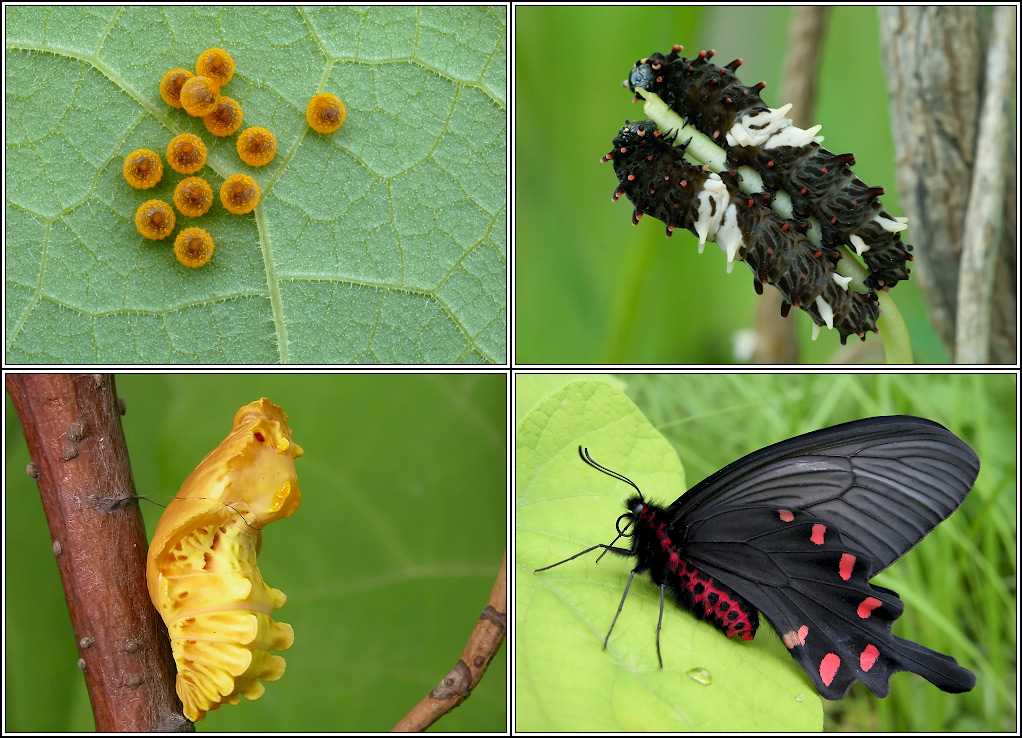
Butterflies are insects and tend to feed on the nectar of flowers. It is the main food source for adults.
Adult butterflies have long and thin nectaries that are able to penetrate into the depths of the flower and get nectar. Nectar contains sugar, which is the main source of energy for butterflies.
Butterflies choose flowers that have bright and attractive colors. This is because brightly colored flowers usually contain more nectar and are richer food sources for butterflies.
In addition to nectar, some species of butterflies can also feed on pollen, plant sap, or even falling fruit. However, most butterflies still prefer the nectar of flowers.
Butterfly nutrition is an important aspect of their life, as it provides them with energy and essential nutrients for survival and reproduction.
Life cycle of butterflies and their lifespan
The life cycle of butterflies goes through several stages of development, each of which has its own duration. The first stage is the egg. The butterfly lays eggs on plants that will serve as food for the caterpillars. The duration of this stage can vary from several days to several weeks, depending on the type of butterfly.
After hatching, the caterpillar emerges from the egg - the second stage of development. Caterpillars actively feed on plant food to accumulate reserves for subsequent transformation into a pupa. The duration of this stage also varies depending on the type of butterfly and environmental conditions. Typically, caterpillars spend from several weeks to several months until they reach the desired size and weight.
The third stage of development is the pupa. The caterpillar turns into a pupa, inside of which amazing transformations occur. Externally, the pupa may look covered with a protective cover or hidden in a cocoon. Metamorphoses occur inside the pupa, as a result of which the wings, legs and other parts of the future butterfly are formed. The duration of this stage can vary from several days to several weeks.
After the transformation is complete, the butterfly hatches from the chrysalis - the fourth stage of development. The new butterfly emerges into the world with soft and folded wings, which over time straighten out and become beautiful. The lifespan of adult butterflies can vary from several days to several weeks, depending on the species and environmental conditions.
Thus, the life cycle of butterflies includes four stages of development: egg, caterpillar, pupa and adult. Each stage has its own duration, which may vary depending on the type of butterfly and environmental conditions.
Diversity of butterfly species in the world
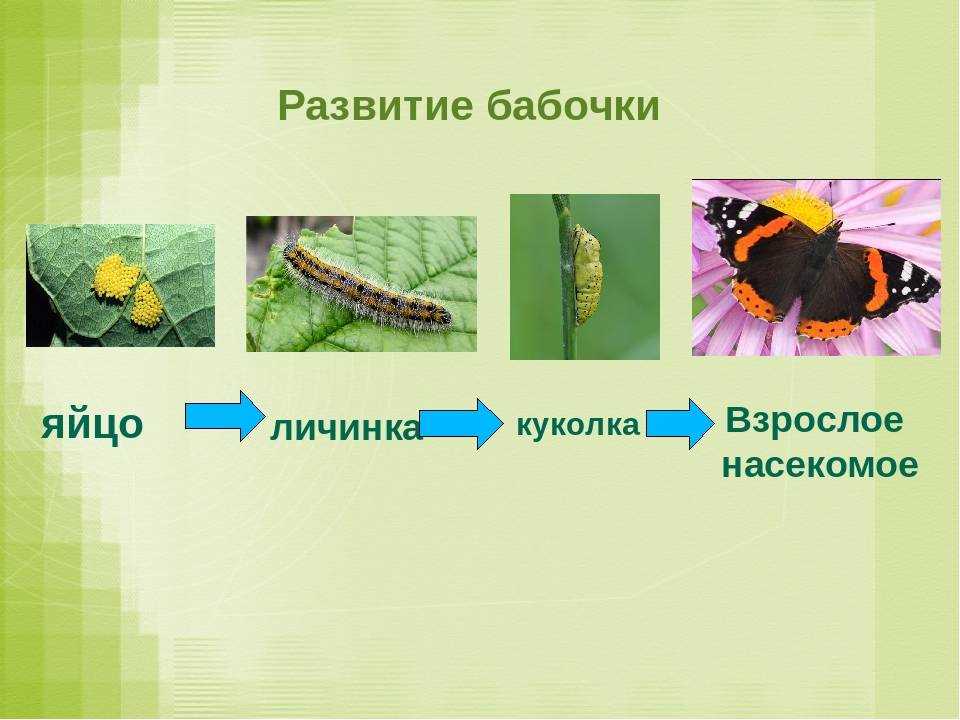
Butterflies are one of the most diverse groups of insects, with more than 18,000 species worldwide. They live on every continent except Antarctica and inhabit a wide range of ecosystems, from tropical forests to polar tundra. Their unique evolutionary history has given them a wide variety of shapes, colors, and behaviors.
The variety of butterfly species can be seen not only in their appearance, but also in their lifestyle. Among them are species that spend their lives mainly in the air, constantly flying from place to place, and species that spend most of their time on the ground or on plants. Some butterflies migrate over vast distances, traveling thousands of miles in search of food or breeding grounds.
Butterflies are also distinguished by the diversity of their caterpillars, which are the first stage of their development. Butterfly caterpillars come in a variety of colors and shapes, and have different methods of defense against predators. Some caterpillars are brightly colored to alert predators to their poisonousness, while others may mimic the appearance of dangerous or nasty insects.
All these amazing features and the diversity of butterfly species make them one of the most amazing groups of insects on the planet. Watching them in nature is a real pleasure, which allows you to learn more about the animal world and its incredible diversity.
Impact of human activity on butterfly populations

Human activities have a significant impact on butterfly populations. One of the main factors affecting their numbers is the destruction of the natural habitats of butterflies under the influence of the expansion of human civilization. Forest areas, fields and meadows, which previously served as a refuge and food source for butterflies, are now being converted into buildings or used for agricultural purposes. This leads to a reduction in available resources for butterflies and a decrease in their numbers.
One of the main problems associated with human activities is the use of pesticides. Chemicals used in agriculture and horticulture are dangerous for butterflies. They can lead to insect poisoning or reduced food availability. Moreover, pesticides can adversely affect the process of metamorphosis itself, making it difficult for caterpillars to become pupae and adult butterflies. This leads to a reduction in the number of populations and even to the extinction of some species.
Climate change also has an impact on butterfly populations, and human activity is one of the reasons for this change. Global warming, caused by greenhouse gas emissions into the atmosphere, leads to a change in the climatic conditions on the planet. Butterflies, like many other species, adapt to certain environmental conditions. Changing temperatures and rainfall can disrupt their life cycle and lead to population declines.
In general, human activities have a negative impact on butterfly populations. Habitat destruction, pesticide use and climate change are reducing the abundance and diversity of these beautiful insects. However, being aware of the problem and taking action to conserve and restore their habitats, as well as reduce the use of harmful chemicals, can help conserve butterfly populations and their role in the ecosystem.

